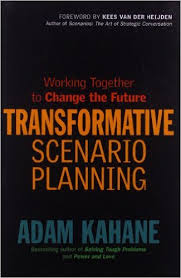I finally got to Transformative Scenario Planning by Adam Kahane. It’s one of those books that stayed too long in my “to-read” pile. It’s a relatively brief and highly readable account of how Adam adapted the Shell approach to use in situations where “people see the situation they are in as unacceptable, unstable, or unsustainable” and the only way out is by working with a group that is representative of the whole system. This means going beyond friends and colleagues and may include dealing with adversaries. He suggests that dealing with “increasing turbulence requires more focus on mobilizing autonomous systems forces.” Analysis is a useful start, but getting stakeholders mobilized is the only way to transform systems. Transformation must be approached indirectly by “building shared understandings, relationships, and intentions. In other words, there are not simple direct solutions for transformation, but it can happen if the stakeholders can be mobilized to find solutions together. The shared understanding can get the system unstuck and open the possibility for a new way forward.
finally got to Transformative Scenario Planning by Adam Kahane. It’s one of those books that stayed too long in my “to-read” pile. It’s a relatively brief and highly readable account of how Adam adapted the Shell approach to use in situations where “people see the situation they are in as unacceptable, unstable, or unsustainable” and the only way out is by working with a group that is representative of the whole system. This means going beyond friends and colleagues and may include dealing with adversaries. He suggests that dealing with “increasing turbulence requires more focus on mobilizing autonomous systems forces.” Analysis is a useful start, but getting stakeholders mobilized is the only way to transform systems. Transformation must be approached indirectly by “building shared understandings, relationships, and intentions. In other words, there are not simple direct solutions for transformation, but it can happen if the stakeholders can be mobilized to find solutions together. The shared understanding can get the system unstuck and open the possibility for a new way forward.
In brief, traditional scenario planning maps plausible futures to suggest how organizations might adapt; Kahane proposes that transforming, rather than adapting, requires a different approach. The key difference is in the purpose – the key is building “a strong alliance of actors who deeply understand the situation, one another, and what they need to do. He shares 20 years of experience working with large groups/communities/nations across the globe, noting where it worked and where it didn’t. And it can be challenging to tell, since it takes a long time for transformation to unfold.
He talks about some of the modifications in the transformative approach, and supports them with real-life examples from his practice.
It was interesting that he aligned his 5-step process along Scharmer’s Theory U.
- Convene a team from across the whole system (co-initiating)
- Observe what is happening (co-sensing)
- Construct stories about what could happen
- Discover what can and must be done (co-presencing)
- Act to transform the system (co-creating)
We futurists have been exploring ways to be more action-oriented. This transformational approaches really fits the bill! Andy Hines
Andy,
You might be interested in paper on this topic that I recently published in the International Journal of Foresight and Innovation Policy, see: http://www.inderscience.com/info/inarticle.php?artid=74396
Cheers,
Stephen
P.S. I’m less enthusiastic about Kahane’s book – it’s seems more a marketing tool to get people to hire him/Reos Partners (as opposed to providing sufficient detail for others to be equipped to run such processes) and is pretty superficial.
Thanks for sharing your piece, Stephen. Always good to have more views in the mix. I, and I’m sure other readers, will find it helpful!
No worries – another way to put the same point (about Adam Kahane’s book) is to recognise that the knowledge of the reader can be a major determinant of the value of the material. Highly experienced practitioners like yourself could pick up the book and probably fairly readily see how you might use/adapt some of the ideas it discusses. However, I think most people would struggle to do so and therefore would need to hire someone else, e.g. Adam Kahane. Hence my point about the books value potentially being more along the lines of marketing Adam Kahane’s services.